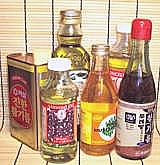 This is a quick summary for the practical cook. For more detailed
information see our Oils
& Fats page.
This is a quick summary for the practical cook. For more detailed
information see our Oils
& Fats page.
Let me state clearly that I am not a licensed medical professional
or nutritionist nor do I play one on TV or claim to be one on dates. The
information presented here has been gathered from publicly available
literature and is not to be, nor can be, considered medical advice. On
the other hand, the medical establishment promoted trans fats for over
70 years, fats now known to be more dangerous than any other. Medical
opinion seems often based more on fad and corporate sponsorship than on
valid science.
Avoid for All Frying and BakingThe fast food industry found these totally unusable because they started to become rancid immediately upon heating and were completely unusable within a few hours (beef tallow was so stable it lasted a month). Products of rancidity are suspected carcinogens. If these oils aren't good enough for Burger King why would you use them?
High Temperature Frying OilsAll these oils will go to at least 450°F/235°C safely and are resistant to rancidity. All oils safe at these temperatures are refined oils except Avocado which may be virgin.
Medium Temperature Frying OilsThese oils will go safely to at least 400°F/200°C and again are all refined oils.
Moderate Temperature Frying OilsAll these oils will go safely to at least 350°F/175°C.
Low Temperature Frying OilsThese oils will all go safely to 300°F/150°C but may lose flavor before they reach that temperature, so 275°F/135°C is a good target maximum. Flavor is generally a major feature (and justification for higher price) with low temperature oils so you don't want to loose it.
Mayonnaise and Emulsified Sauces
Salad Oils
Reusing OilOils with a low oxidative stability index (1.5 and lower) can be reused several times provided they have not been overheated (to smoking or higher), they are filtered clean after use, and not too much time passes between uses. Oils with a higher oxidation index (polyunsaturated oils) should never be reused as they degrade rapidly. After using a stable oil for deep frying I often reuse it a bit at a time for pan frying (if the flavor remains neutral). Oil used to fry fish should not be reused for any other purpose because it will become strongly flavored from dissolved fish oils, and these oils are not temperature stable. To filter oil, line a wire strainer with a non-colored paper towel and pour the oil through it. Preferably it should still be fairly hot so it filters quickly. In some cases the filter will clog and have to be replaced before all the oil is filtered. Sticking ProblemsOften problem foods that stick to the pan with most oils will not stick if fried in Lard. Yes, the American Heart Association has vilified lard and made you fear it, but in the 19th century America practically lived on pig fat and congestive heart disease was almost unknown. Populations using a lot of lard and people on the Atkins diet have not experienced an elevated incidence of heart disease. There seems to be something amiss with AHA "science". Cleanup ProblemsIt is best to grease baking pans and the like with lard or beef tallow. Vegetable oils dry quickly to varnish and become very difficult to clean off. If oil is not baked on too hard, paint thinner may be useful for removing it - but be very cautious of the fire hazard. More Information
|
oi_cookz 081109 - www.clovegarden.com
©Andrew Grygus - agryg@clovegaren.com -
Linking to and non-commercial use of this page permitted